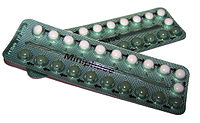
Photo from wikipedia
BACKGROUND Although observational studies have shown an association between sex hormone-binding globulin (SHBG), testosterone (T) and cardiovascular diseases (CVD), controversy remains. In this study, we aim to explore the causal… Click to show full abstract
BACKGROUND Although observational studies have shown an association between sex hormone-binding globulin (SHBG), testosterone (T) and cardiovascular diseases (CVD), controversy remains. In this study, we aim to explore the causal effects of SHBG and T on Coronary heart disease (CHD). METHODS We used univariable, network and multivariable mendelian randomization (MR) analysis to investigate the causal effect of SHBG and T on CHD. We performed inverse variance weighted (IVW) MR as the primary analysis, with the robustness of this approach further tested by other methods in sensitivity analysis. The SHBG and T were collected from the UK Biobank data, about 180,000 men aged 40 to 69 years. CHD was collected from CARDIoGRAMplusC4D 1000 Genomes-based GWAS, which was a meta-analysis including 48 studies and involving 60,801 CHD cases and 123,504 controls. RESULTS Using univariable MR-IVW, the results suggested that a one standard deviation (SD) increase in SHBG, the risk of CHD decreased by approximately 14% (OR (95%CI): 0.86(0.76,0.97)), and that a SD increase in total testosterone (TT), the risk also decreased, approximately 8% (OR (95%CI): 0.92(0.85,0.99)). Multivariable MR showed that both SHBG and TT had no direct causal effect with CHD (a SD increase in SHBG: OR (95%CI):0.75(0.57,1.00), P = 0.053; a SD increase in TT: OR (95%CI): 1.05(0.90,1.22), P = 0.53). In the network MR analysis, the results suggested that TT might act as mediator in the causal pathway from SHBG to CHD and account for 93% of the total effect of SHBG on CHD, and that SHBG might be a mediator in the causal pathway from TT to CHD and account for 67% of the total effect of TT on CHD. CONCLUSIONS Genetically predicted SHBG and TT were negatively correlated with CHD in both univariable and network MR, which may provide a causal explanation behind the observed conclusion. In addition, TT and SHBG had a bidirectional causal effect. Further work is required to disentangle the downstream effects of SHBG/TT on CHD and the molecular pathways involved, as the simultaneous regulation of SHBG and TT may make it a viable strategy for the prevention or treatment of CHD.
Journal Title: International journal of cardiology
Year Published: 2021
Link to full text (if available)
Share on Social Media: Sign Up to like & get
recommendations!